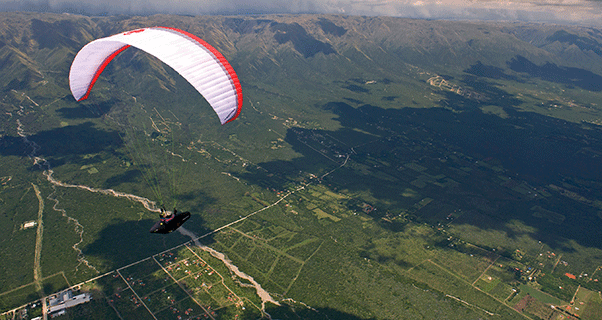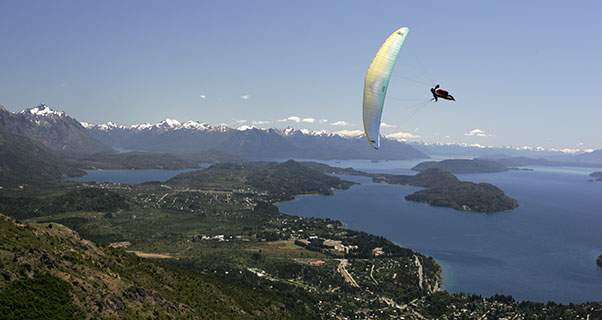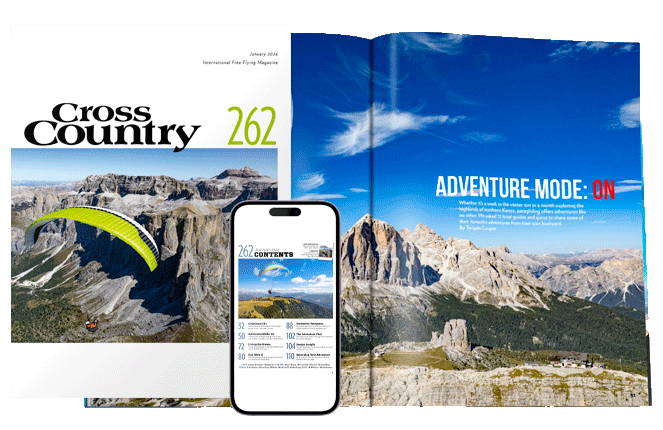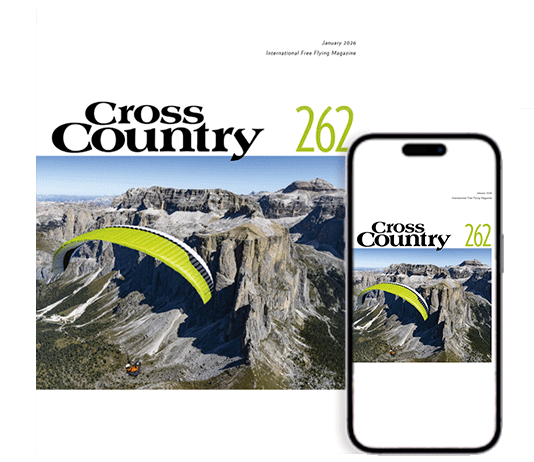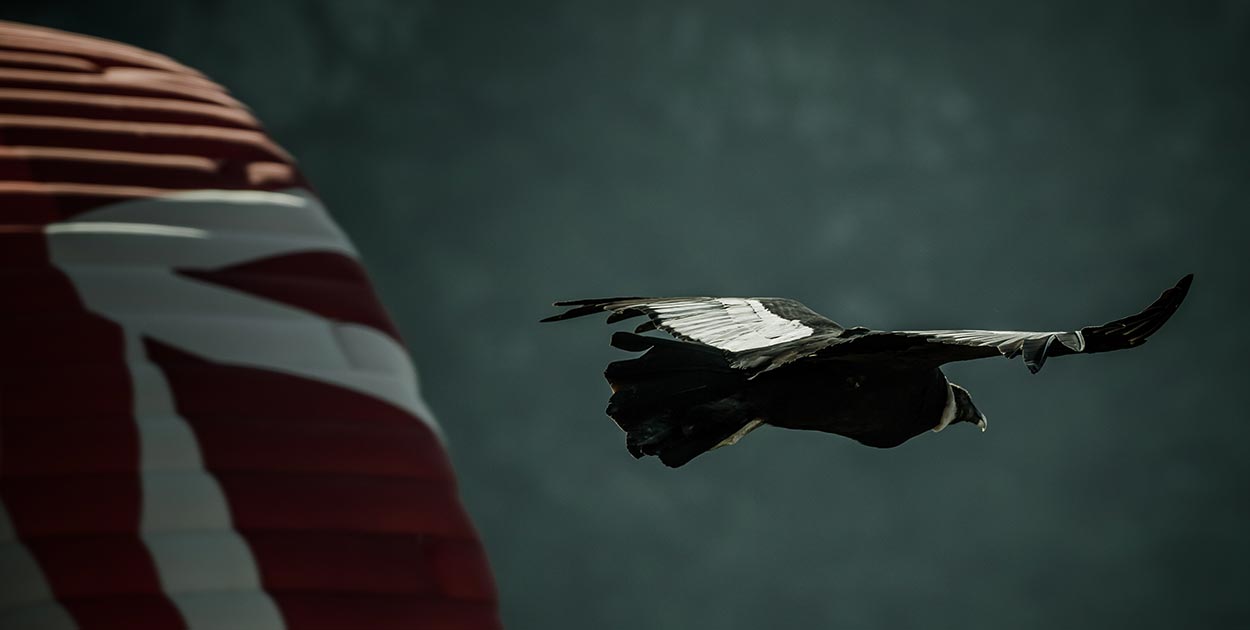
Flying with Condors in Argentina
10 January, 2018Curious and non-aggressive, the condors of Argentina are a unique wingman to share the sky with. Cuchi Corral is one of the main sites in northern Argentina, and here it’s normal to fly with condors, but there are plenty of other sites in the area that also offer airtime with the big bird.
Condors have a three-metre wingspan, and are curious – they are just as keen to fly with you as you are with them. The juveniles, recognisable by their brown feathers which turn black in adulthood, can get a little playful in the air, so give them a little more room.
The nearby village of La Cumbre where most pilots stay is a tourist village, popular with weekenders from Buenos Aires looking to escape the sea-level summer heat in exchange for the cool mountain air at 1,400m. This was the country’s first ever paragliding site and there’s a thriving tandem trade here. There’s no shuttle from town to take-off, but you can get a taxi, or catch a ride with the welcoming tandem pilots. If you bomb out, the LZ restaurant owner runs a shuttle every hour back to the top for a few euros. Andy “Airman” Hediger’s Aeroclub, famous for teaching all types of aviation, is just down the road.
Flying happens all year, and there are conditions to suit every level: from light sled-rides on winter mornings to 10m/s hold-on-to-your-breakfast thermals in the middle of the day in summer.
At all times of day though the take-off can get gusty with cycles, so a good reverse launch technique will save you getting dragged. XC pilots typically launch at around 11am and fly until 4pm.
In the summer season expect to be flying in 6-7m/s lift and once you’re up you have the choice of flatlands out front, or mountains if you follow the ridge in either direction to the sides. Usually it’s technical flying using the relief to guide you, but on days when it’s really working you can get the height to make the job of chewing up miles very relaxing.
When to go
Flyable all year round, but October, November and December are best.
Altitudes
Take-off 1,100m, landing 700m.
Cloudbase
Typically around 2,000m, but pilots have been known to reach 4,500m.
Hang glider access
Yes. The take-off has a good ramp and the fact it can blow quite hard makes it a good spot for hangies. Andy Hediger is one of the only local HG pilots who speaks English and is a good first point of contact.
Must be flown
Hernan Pitocco has flown 230km from here, but a more realistic expectation would be 80-100km. Comp tasks are usually set at an achievable 60-90km. The west wind usually has a north or south component, which can switch during the day. It means you can have a following wind on both your out and return legs.
Heading south, a 50km out-and-return to Lake San Roque is a satisfying day’s flight on modest cloudbase days. Heading north you’ll reach the hippy village of San Marcos Sierra. There you can upgrade your out-and-return for a triangle. Head east to Uritorco mountain, infamous for UFO sightings, then turn back towards Cuchi Corral. Depending on how ambitiously you push the corners, you can log a 60-100km triangle.
Dangers and annoyances
Cold fronts with high winds move in fast and even though the black wall of cloud looks like it will take an hour to get to you, it can be upon you in minutes! Talk with local pilots and tune in to the shared radio frequency for updates. In summer, the big mountains dump their katabatic winds from around 3-4pm making for gusty winds in the official landing. Land 5km further away from the ridge and be prepared for a post-flight hike. The local tandem pilots are very helpful and safety is a priority, so expect them to take a well-meaning interest in your skill level and heed their advice.
Guides and courses
FlyinArg.com run trips seasonally during the summer, November onwards.
Accommodation
There’s a pilot hostel in town with dorms. For more privacy, Fly in Arg rent rooms in their large house a little way out of town, bundled in with a shuttle service and local flying advice.
Take the family and rainy days
Mountain biking, river swimming, sunbathing, barbecue, beer, golf, horse riding, skydiving and microlighting.
Weather
Windguru and XCSkies work well enough, but don’t expect the same accuracy as in Europe or North America. The best sources are the local tandem pilots.
Getting there
La Cumbre is a 90-min drive from Córdoba city. You can get to Córdoba direct from Spain on Air Europe, or via Buenos Aires. If independent hire a car, because public transport will suck up hours of your life in Argentina.
Other places to hang with condors
Mina Clavero: 10km from La Cumbre and site of a PWC in 2014. Launch is at 1,500m and landing is 1,200m. The site is set on a long ridge, so distances are relatively easy to make: choose flatlands or mountains rising to 2,800m. There are two nesting areas for condors nearby. One is 1km north with about 60 condors. The other is 15km behind, in a national park that supports the biggest community in South America. It’s home to 400 condors.
Puesto Pedernera: While the Mina Clavero take-off looks to the west, Puesto Pedernera is on the same spine looking to the east. The take-off is nicely contoured and gives easy soaring while you look for that first climb. Let the condors guide you south to La Cumbrecita, a village founded by German settlers that looks unmistakably alpine.
Merlo: The picturesque village of Merlo is in the neighbouring province of San Luis. It has the highest take-off in Argentina at 2,100m but there are four official launches at different altitudes up the side of the mountain. You can reach them all by car. The highest one is next to a tourist viewpoint and restaurant. The sky here is full of condors, and tandem pilots.
Famatina: 400km north of Cuchi Corral, Famatina in La Rioja province is a tiny village high in the desert mountains. Take-off is over a big valley venturi point, so there’s always a breeze, and by midday it can get blown out. Along the base of this ridge, 700m below, is the Pan-American highway (easy retrieves). You can fly twice a day: thermals from 10am; restitution in the evening. In a full moon pilots fly after sunset and land by the light of car headlights. As if that’s not magical enough, the birds fly late into the evening too.
Sick of condors? Thirty minutes from Córdoba city is the biggest paragliding school in Argentina, Escuela Voler. Their site is flyable most days of the year and even though it’s only 70m from top to bottom you can fly 80km back to Cuchi Corral from here. You won’t see any condors until you get away from Córdoba.


